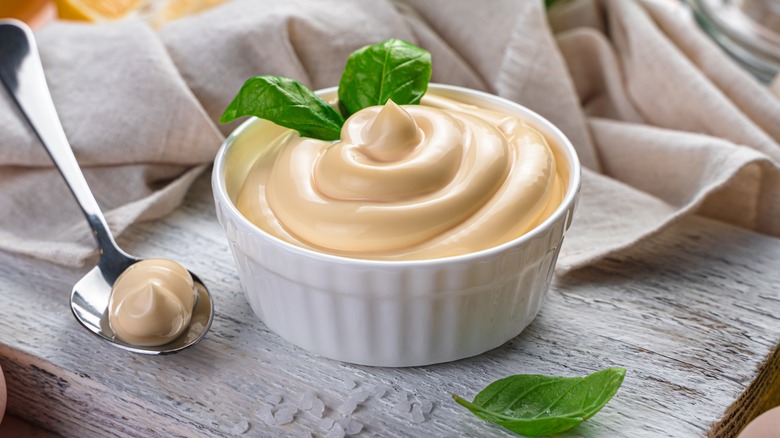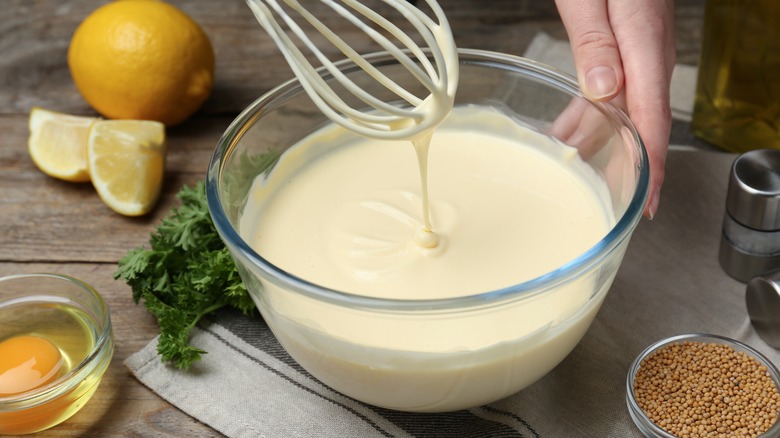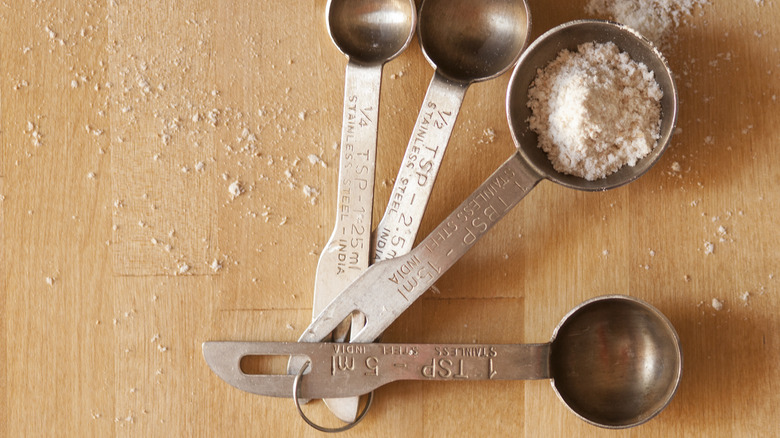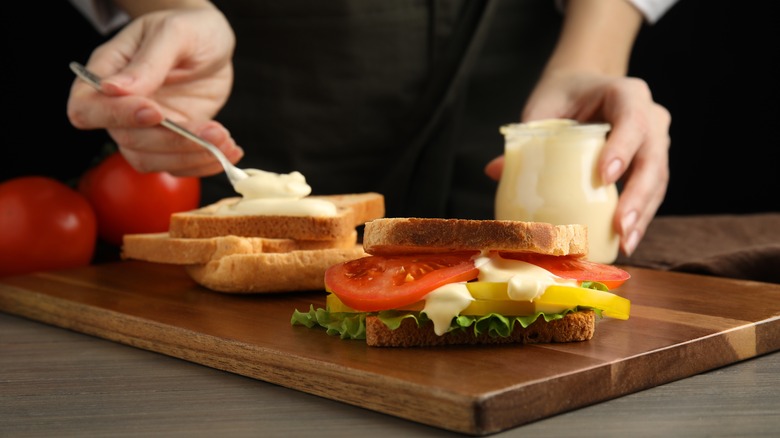How To Thin Out Homemade Mayo When It Gets A Bit Too Thick
Making your own mayonnaise at home is relatively easy, but the recipe can go awry if the combination of ingredients is out of whack. Adding too much oil is a common problem when making this delicious condiment on your own — one that can result in mayo being far too thick for your liking. The key to good mayo consistency is to use the proper ratio of water to oil, and when portions are off, you'll find that the finished product is too thin or too thick.
Like most kitchen mishaps, a little tweaking can save your recipe and prevent you from starting over from scratch. Thickness can be reduced by adding a thinner liquid to the mixture, such as water. Ideally, mayo will have a voluminous texture with a bit of airiness, which you can test by whisking. If the whisk creates small ribbon-like peaks in the mixture as you go, the desired consistency has been achieved. If the mix is too dense or gloopy, adding water is an easy yet effective way to reduce the thickness of the mayo.
Add water to finished mayonnaise mixture
Properly incorporating oil and water is a key aspect of emulsification, which is a process that allows two disparate substances (i.e., oil and water) to combine successfully. That's why mayonnaise recipes recommend extreme caution when incorporating the oil, as pouring in oil too quickly will prevent the water and oil from fully merging. Along with adding oil too quickly, adding too much oil causes mayo to thicken, which is where the water trick comes in.
If you're not fully satisfied with the consistency of the condiment, begin adding water while the mayonnaise is still being mixed. Adding more water as the mixture is in motion promotes emulsification, while also helping to thin out the mayonnaise for an improved texture. How much water you add typically depends on how much oil was added during the initial steps. In this case, there's a helpful formula you can use to achieve the desired consistency.
Increase the water volume to achieve correct consistency
When adding water to fix your homemade mayo, be mindful of how much you're adding at a time. In general, it's best to only add a small amount of water, typically 1 teaspoon, at a time to avoid making the mixture too thin. If you have a set of measuring spoons, look for the specific measurements on the handle to ensure you're adding the proper amount of water. The spoon may be marked with the letters "t" or "tsp." Teaspoons may also be marked by the abbreviation "tspn."
In the event you can't track down your measuring spoon set, you'll have to estimate how much water to add to the mayo recipe. In this case, it helps to have a visual representation of a teaspoon to keep measurements accurate. Remember that 1 teaspoon is equal to 5 ml, which is equivalent to the distance between the very tip of your pointer finger (aka the index finger) and the first knuckle on that finger.
How long will homemade mayonnaise last?
Once you're completely satisfied with the outcome of your homemade mayonnaise, you must store it properly to ensure you can enjoy it for as long as possible. In this case, it's best to transfer the mayo to an airtight container and store it in the refrigerator. Homemade mayo can maintain its quality for up to two weeks when kept in cool temperatures. After two weeks, the flavor and texture of the condiment is likely to diminish, and the risk of foodborne illness will increase.
There is a way to increase the lifespan of homemade mayonnaise, and it requires the incorporation of an additional ingredient. Whey, a by-product of the process used to make yogurt and cheese, can actually extend the lifespan of mayo by fermenting it. When whey is added, mayonnaise can remain good for up to a month in the refrigerator. Liquid whey can be challenging to find, as powdered products are most common, but you may be able to track some down at farmer's markets and health food stores.
Homemade mayonnaise recipe
A good recipe can keep you on the straight and narrow when it comes to avoiding texture and flavor issues. For instance, this homemade mayonnaise recipe features clear instructions on which ingredients to add and how to incorporate them effectively. The first step is to bring together your ingredients, which include an egg, extra virgin olive oil, lemon juice, and Dijon mustard. This mayo is seasoned simply with salt and pepper to allow the flavors of the other ingredients to shine. You'll also need a blender or food processor to properly mix ingredients and achieve the best possible texture.
To get started, add the lemon juice, egg, and mustard to your food processor or blender basin, then add salt and pepper into the mix. Begin blending ingredients together, then add olive oil while the device is still in motion. It's best to incorporate the oil slowly into the mix to maintain optimal consistency. Continue to blend the mayonnaise until ingredients are fully integrated and you're satisfied with the thickness and texture.




